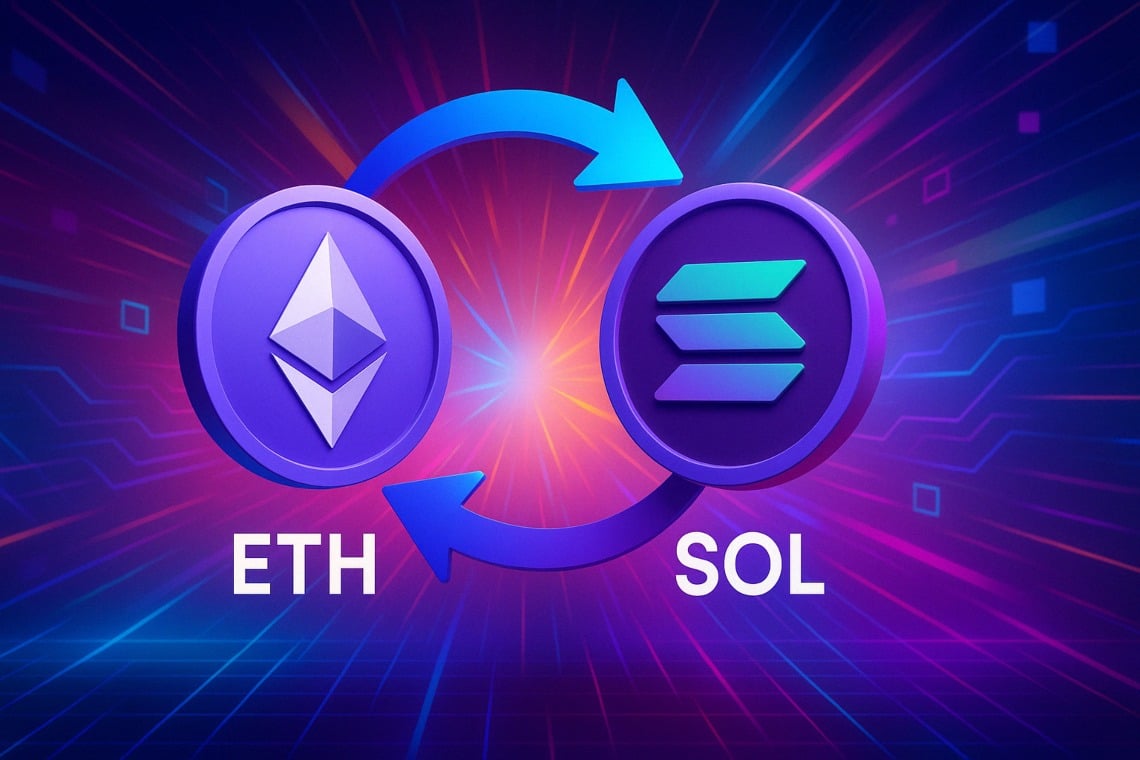According to on-chain data reported by Wu Blockchain, Galaxy Digital transferred 65,600 ETH, equivalent to approximately 105 million dollars, to Binance and subsequently withdrew 752,240 SOL, valued at approximately 98.37 million dollars.
This operation represents a clear signal of strategy change by the company, which seems to want to reduce its exposure to Ethereum to decisively focus on Solana, a blockchain that in recent months has shown signs of steady and robust growth.
Ethereum (ETH) decreasing, Solana (SOL) growing: Galaxy Digital takes advantage of the market
The market data is clear: Solana (SOL) has recorded an increase of 8% in the last month, while Ethereum (ETH) has experienced a decline close to 20%. This performance gap may have prompted Galaxy Digital to reconsider its asset allocation.
According to a recent report by Standard Chartered, Ethereum is in a phase of “structural decline”, so much so that the bank has revised its price target downward for the end of the year. The decline in confidence towards ETH is also reflected in the data related to Ethereum ETFs, which have recorded an outflow of nearly 600 million dollars in the last two months.
Solana surpasses Ethereum in key metrics
Supporting Galaxy Digital’s choice are also numerous on-chain indicators that highlight Solana’s growing strength compared to Ethereum. In particular, the transaction volume on Solana’s DEX (decentralized exchanges) has exceeded 500 billion dollars in the last three months, while Ethereum has stopped below 400 billion.
The number of indirizzi attivi is also a significant figure: Solana has over 220 million indirizzi attivi, a number significantly higher compared to the 80 million combined of Ethereum and its Layer-2 solutions.
These numbers indicate a greater adoption and real use of the Solana network, which seems to be gaining ground as a faster and cheaper alternative compared to Ethereum.
Justin Sun’s proposal: a tax on Layer-2
In an attempt to counter the decline of Ethereum, an interesting proposal has emerged from Justin Sun, founder of Tron. Sun suggested the introduction of a tax on Ethereum’s Layer-2 solutions, with the aim of using the collected funds to buy back and burn ETH in a completely decentralized manner.
However, this proposal has not yet been formalized in an Ethereum Improvement Proposal (EIP), the first necessary step to initiate an official process of modifying the Ethereum network. It remains, therefore, a simple idea, without any concrete impact in the short term.
The new composition of Galaxy Digital’s portfolio: ETH makes room for SOL
Despite the recent operation, Galaxy Digital still holds a significant stake in Ethereum. According to data from the Arkham platform, the company currently owns 87.9 million dollars in ETH and 23.86 million dollars in SOL. However, the move of over 100 million dollars represents a clear signal of strategic rebalancing of the portfolio, with growing confidence in the potential of Solana.
Galaxy Digital has not released official comments regarding the transaction, but the operation has been widely observed and analyzed by the crypto community, which sees in this choice a possible paradigm shift in the sector of institutional investments in criptovalute.
Can Ethereum reverse the trend?
Despite the difficult moment, Ethereum remains one of the most established and used blockchains in the world. According to Standard Chartered, the tokenization of real-world assets could represent a key to stabilizing the network and boosting its value.
However, to regain the trust of investors, Ethereum will have to face significant challenges, including scalability, competition from Layer-2, and the growing pressure from alternative blockchains like Solana, which offer superior performance at lower costs.
Conclusion: Solana establishes itself as a protagonist in the market
The decision by Galaxy Digital to convert a significant portion of its Ethereum reserves into Solana is not just a tactical move, but it could represent a wider signal of transformation in the cryptocurrency landscape. With strong growth metrics, an increasingly active ecosystem, and a network capable of handling high volumes, Solana is establishing itself as one of the main alternatives to Ethereum.
It remains to be seen if this trend will consolidate in the coming months or if Ethereum will be able to respond with innovations capable of relaunching its central role in the world of decentralized finance. For now, however, the wind seems to be blowing in favor of Solana.
